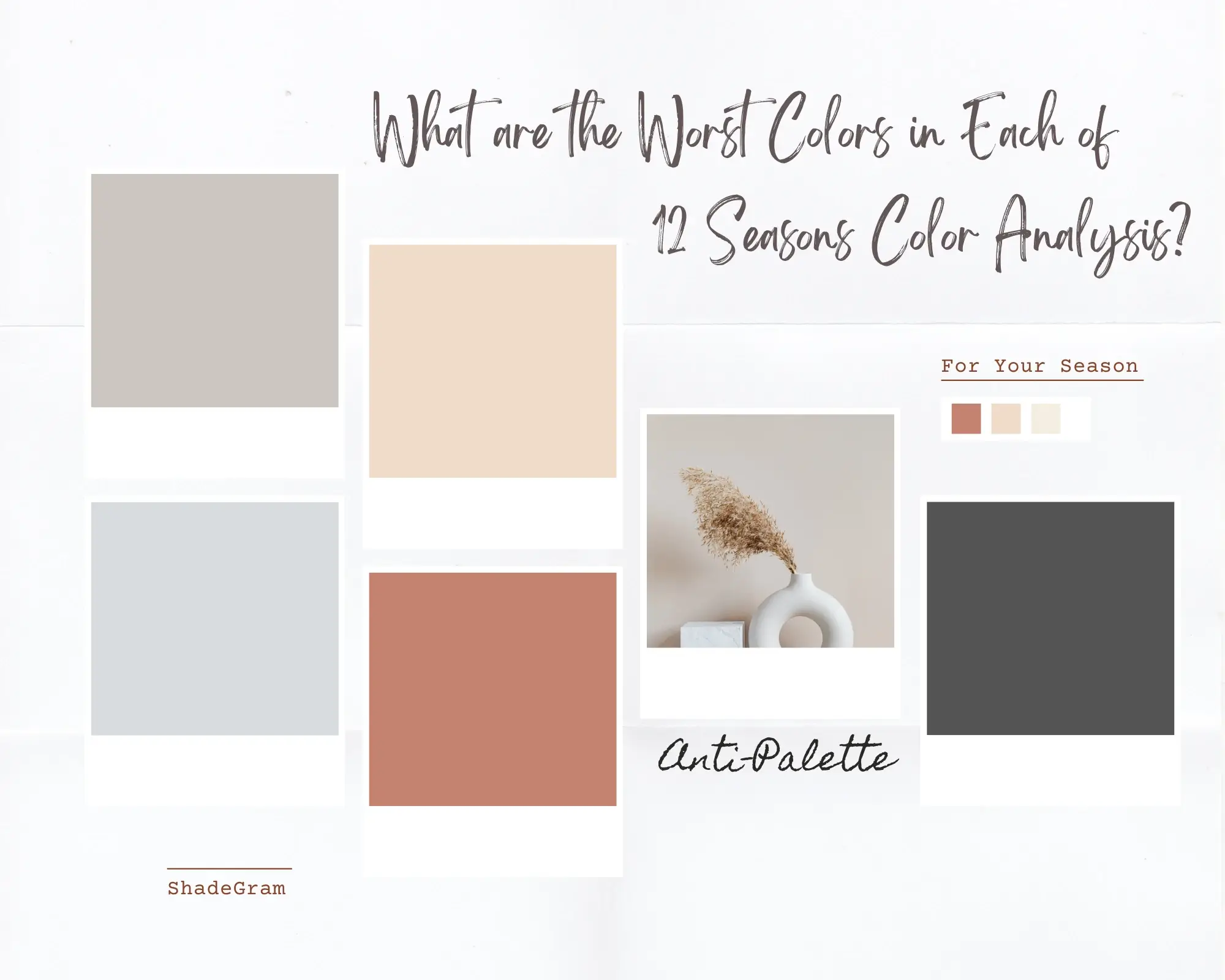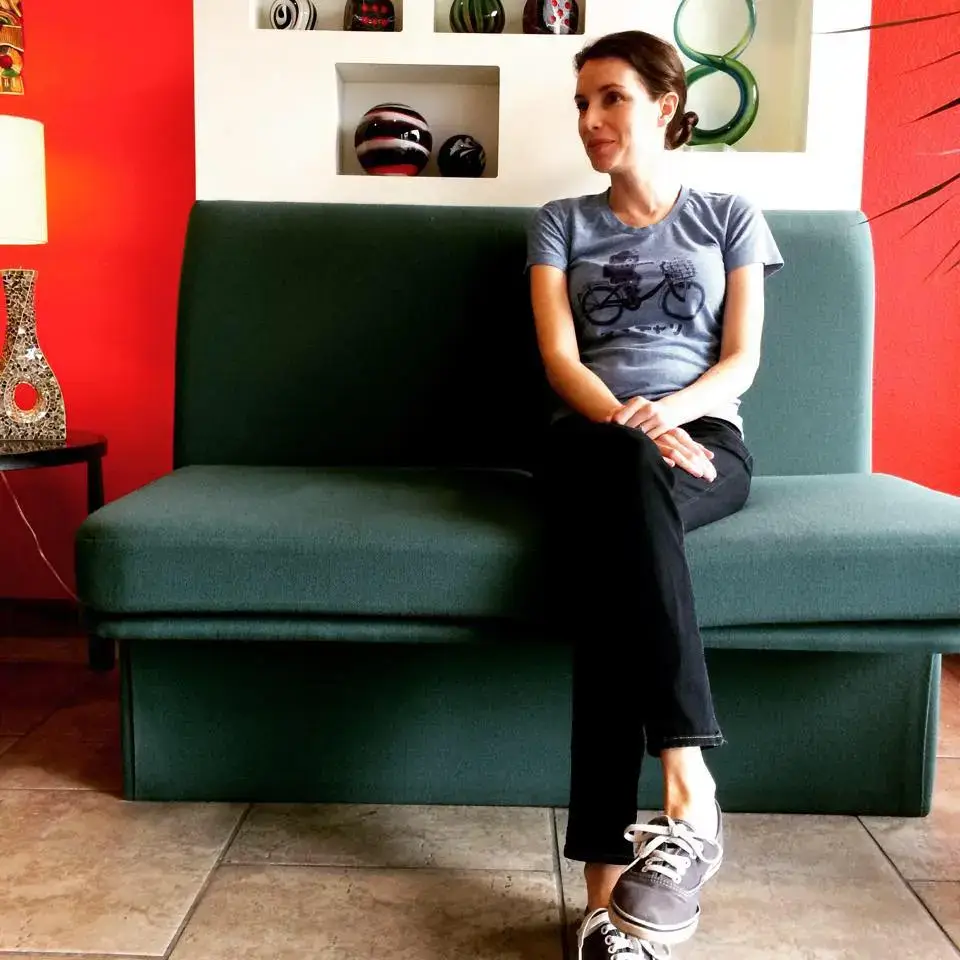Ever tried on a piece of clothing or makeup and just felt off? Maybe your skin looks dull, your eyes lose their spark, or you feel washed out.
It’s frustrating, and happens due to a mismatch between your natural coloring and the colors you wear. A lot of style advice focuses to find your “best” colors. But here’s something equally important to learn: your “anti-palette.”
I will help you identify and avoid the worst colors for your complexion using the 12-season color analysis system. You’ll learn which shades to sidestep, refine your style, and present your best self every day. Let’s get into it!
Some Basics You Must Know
- Seasonal color analysis groups colors based on skin, hair, and eye characteristics. It uses factors like temperature, value, chroma, and draping.
- Undertones: warm, cool, or neutral help determine which colors flatter you and avoid clashes.
- You can experiment with color draping in natural light to see how different hues react with your complexion.
- Understand your season first to select colors that enhance your natural features, and make you look balanced and vibrant.
Unflattering Colors for Each of the 12 Seasons
1. True Spring
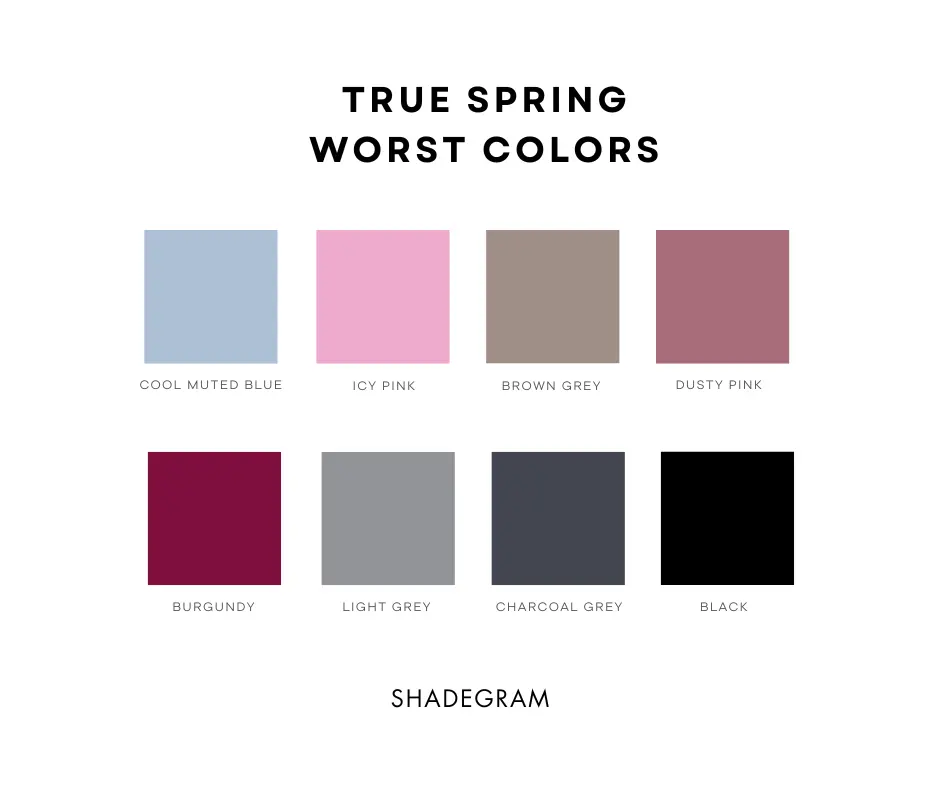
True Spring individuals have a warm, bright, and clear complexion. The optimal colors are vibrant, warm, and clear. Wearing colors that are cool, muted, or very dark can clash with the natural coloring, and make them appear sallow, tired, or washed out. The opposite seasons are true summer and true winter.
Colors to Avoid:
- Cool Colors: Icy blue, true black, dusty rose, and fuchsia. They are too cool and can make you look dull and drained.
- Muted Colors: Dusty pink, cool grey, and olive green. These colors lack the brightness and warmth true springs need.
- Dark Colors: Burgundy, dark olive green, and charcoal grey. These deep tones can overwhelm True Springs’ complexion, and create harsh contrasts.
- Bright or neon hues also do not suit true springs, as they overpower the delicate warmth and balance.
Why They Clash:
These colors make true springs appear dull or drained. Dark and muted shades hide the natural warmth and radiance of their skin. The contrast between the soft, lively features and these heavy, dull colors just doesn’t align.
2. Light Spring
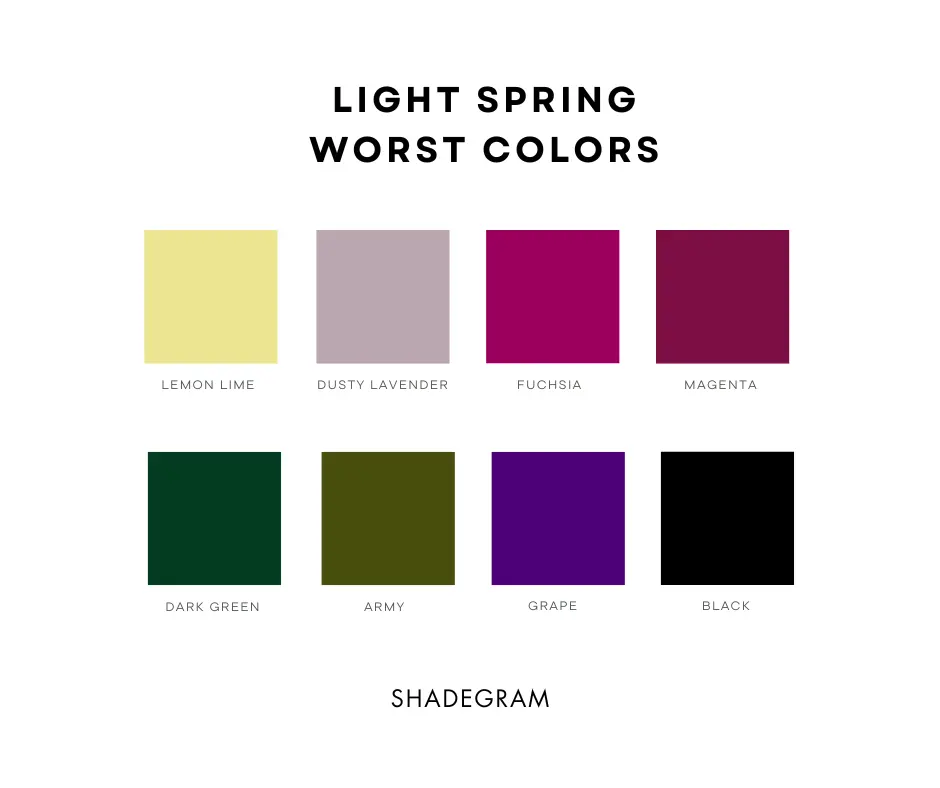
Light Spring individuals have a warm, light, and relatively soft complexion, with a delicate, ethereal appearance. The best colors are light, warm, and clear. They should avoid wearing colors that are very dark, muted pastels, or overly bright. The opposite season is deep winter.
Colors to Avoid
- True black, deep navy, dark burgundy, dark emerald green, deep forest green.
- Dusty lavender, fuchsia, magenta.
- Neon pink, royal purple, neon green, electric blue.
Why They Clash?
Very dark shades will diminish your naturally light and fresh appearance. For example, avoid navy or black, as these colors create harsh contrast with your soft features.
Pastels that are too cool or muted, like dusty lavender, will also clash with your warm undertones and lighten your complexion excessively.
Heavy, saturated colors such as burgundy or forest green can feel overwhelming. Instead, you benefit from light, warm, and clear shades that let your brightness shine.
3. Bright Spring
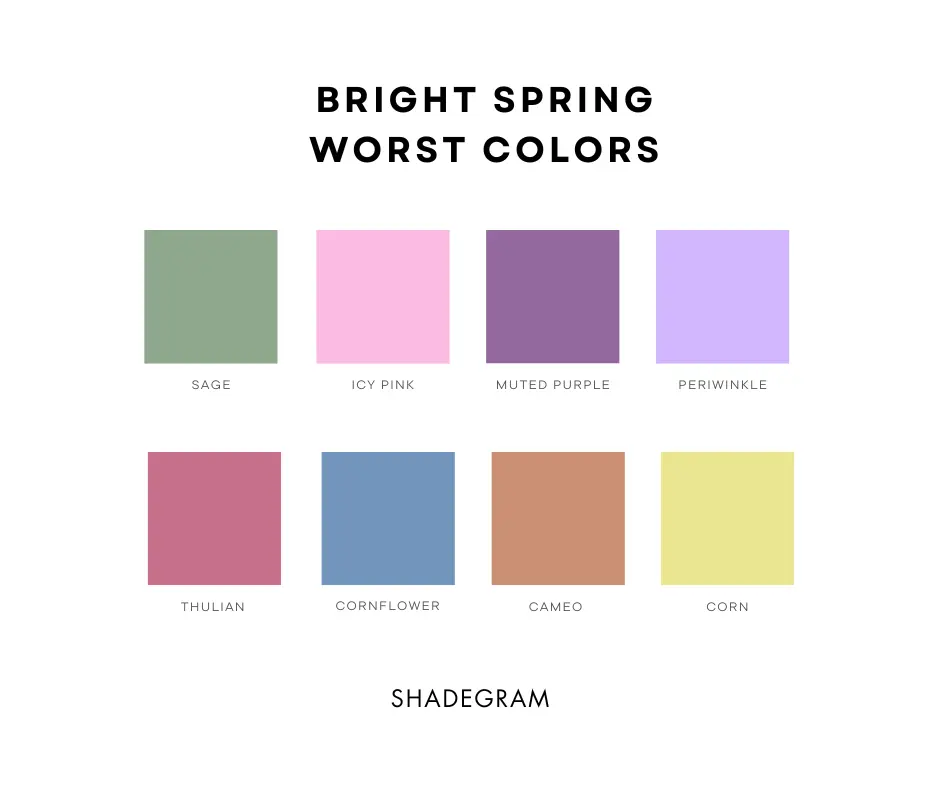
Bright Spring individuals have a warm, bright, and moderate complexion, and clear, energetic, and vivid features. Their main colors are bright, warm, and clear. The worst colors are muted, dusty, or very cool. The opposite season is soft summer.
Colors to Avoid
- Muted olive green, dusty rose, cool grey, soft burgundy, pastel blue, muted teal.
- Muted purple, muddy taupe, soft beige.
- Neon pink, neon green, electric blue.
Why They Clash?
The muted and dull colors will sap your natural vibrancy. Colors like soft beige can make you look tired or washed out.
Also, low-intensity, pastel colors are also less flattering, as they fail to support your bright and energetic look. Stick to clear, warm, and saturated colors instead.
4. True Summer
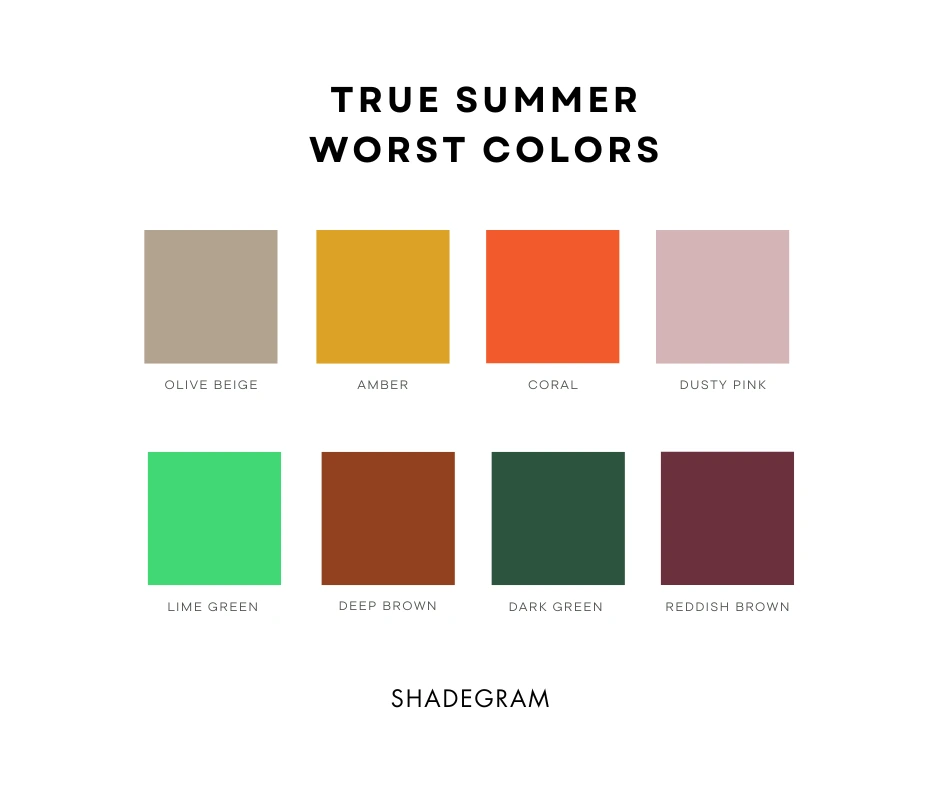
True Summers have a cool, soft, and light complexion, and delicate and muted features. The optimal colors are cool, soft, and medium in value. The colors to avoid are warm greens, warm yellows, and oranges. The opposite season are True Spring and True Autumn.
Colors to Avoid
- Any oranges, mustard, warm yellows.
- Emerald green, olive (warm greens).
- deep rust, brick red, neon colors.
- True black and very deep browns (warm).
Why They Clash?
True summer has cool undertones combined with a moderate level of brightness. The warm and muted shades disrupt your cool color balance and can dull your complexion.
Also, black and very deep browns, are unsuitable because they create too harsh a contrast. So, opt for soft, cool shades that complement you.
5. Light Summer

Light summers are delicate with cool undertones and a light, gentle, airy appearance. Their main colors are light, cool, and clear. They should avoid wearing very dark, very bright, or very warm colors. The opposite season is deep autumn.
Colors to Avoid
- Pure white, black, deep greens and reds
- Intense oranges and yellows
- Dark brown, rust, deep burgundy, neon green, bright orange
Why They Clash?
The dark, heavy colors like deep browns, black, or strong navy will overpower your softness.
Also, warm and saturated tones such as bright oranges or intense yellows will also clash with your cool, pale features. Stick clear from anything too bold or warm to maintain your natural harmony.
6. Soft Summer
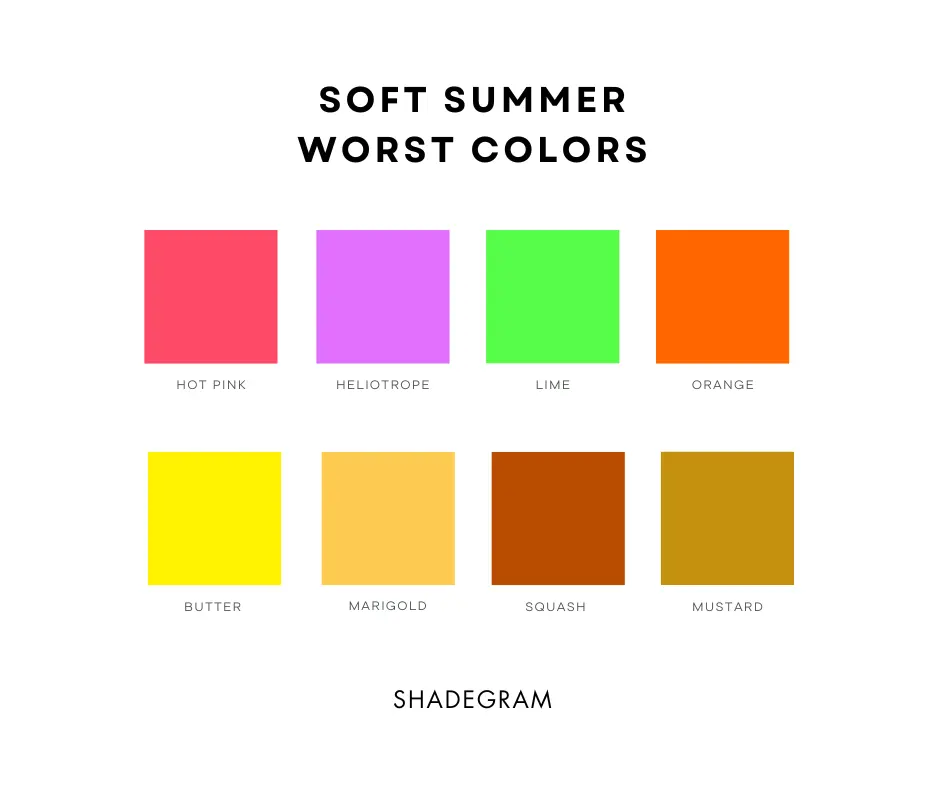
Soft Summer is characterized by cool undertones with muted, gentle hues. The best colors that are soft, cool, and somewhat muted. So, steer clear of anything intense or overly warm that disrupts your subtle balance. The opposite season is bright spring.
Colors to Avoid
- Bright (reds, oranges, yellows, greens)
- Bright pinks, magenta, bright purples
- True black, pure white
Why They Clash?
Bright, saturated colors like vivid reds, bright oranges overwhelm your muted palette and soften your features. Also, high contrast combinations, such as stark blacks and whites, can be too bold and unflattering.
7. True Autumn
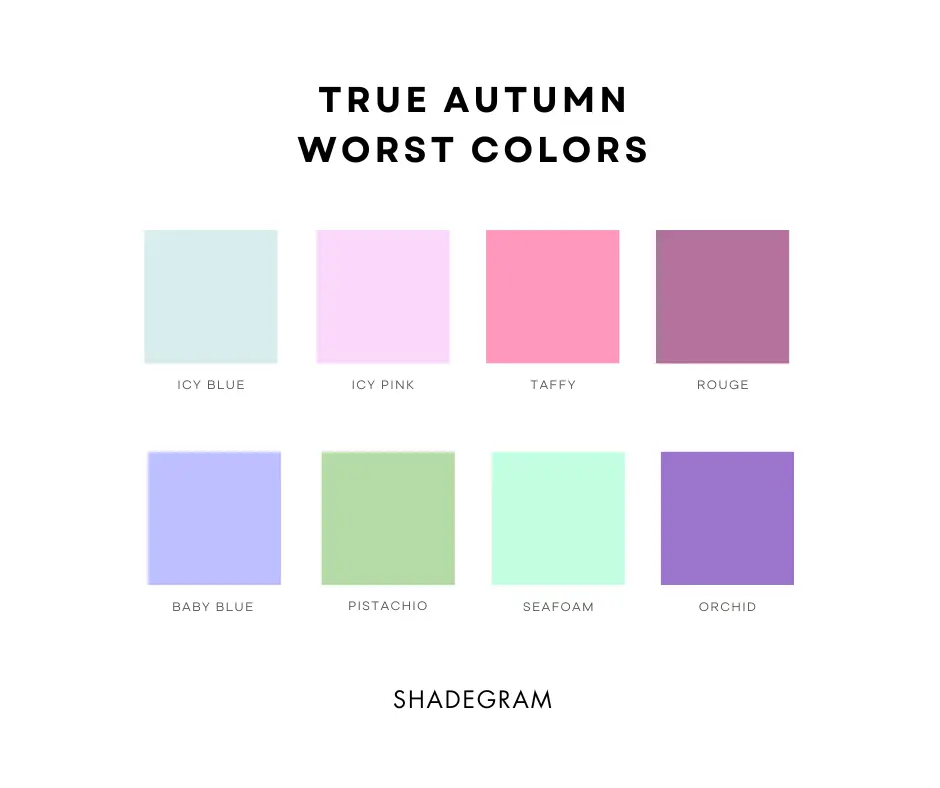
True Autumn features warm, muted, and deep complexion, and rich, earthy features. The best colors are warm, muted, and medium to dark in value. The colors to avoid are cool or blue-based colors such as icy grays, pastel blues, or bright pinks. The opposite seasons are true summer and true winter.
Colors to Avoid
- True black, pure white
- Cool blues and cool pinks
- Cool purples and cool greens
Why They Clash?
Coolblues and pinks can clash strongly with your warm base and diminish your natural glow. Also, highly saturated or neon shades will feel artificial against your deeper warm palette.
Pure black and stark white also tend to drain your warmth, and make your skin appear dull. Focus instead on rich, warm tones that feel harmonious with your natural coloring.
8. Soft Autumn
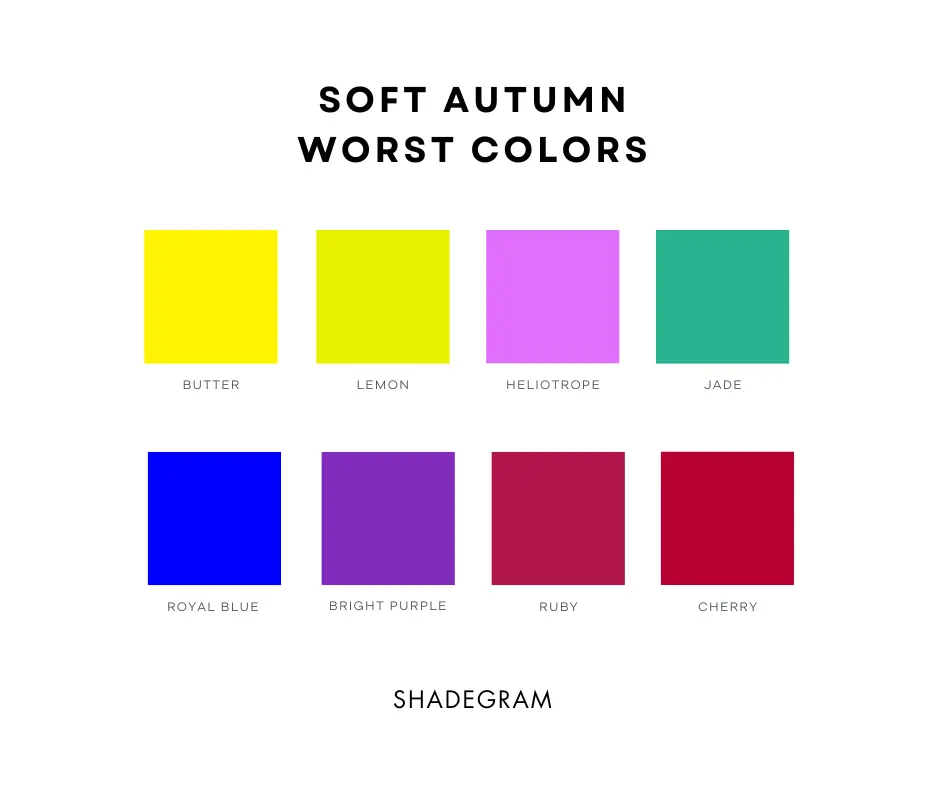
Soft Autumn has low contrast between hair, skin, and eyes, and a muted and warm undertone. The colors are warm, muted, and medium in value. The colors to avoid are too cool and bright, or very light. The opposite season is Bright Winter.
Colors to Avoid
- True black, pure white.
- Neon pink, bright royal blue.
- Fiery red, pure yellow.
- Magenta and bright pinks.
- Bright purple
- Bright yellow
Why They Clash?
Colors that are too bright or cool will overpower your subtle warmth. Also, pastel pinks and bright jewel tones don’t harmonize with your muted palette. Instead, they highlight the contrast in an unflattering way. Colors like neon or pure white may sharpen edges too much, and reduce the softness that defines your natural coloring.
9. Deep Autumn
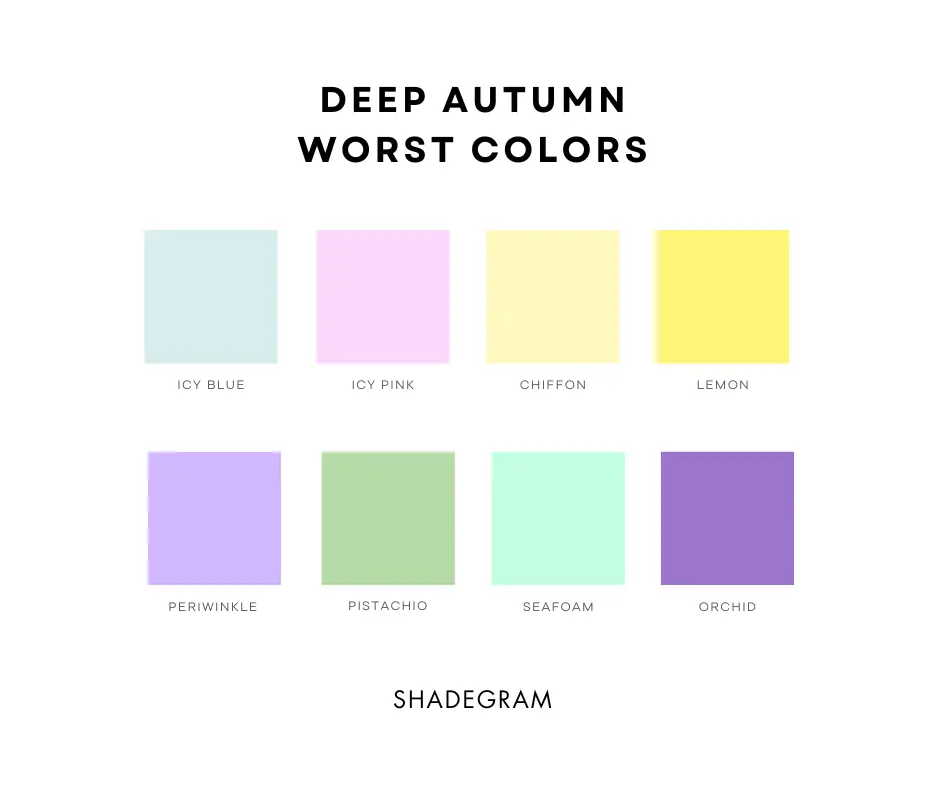
Deep Autumn has high contrast with warm and deep undertones, bordering on shades found in deep winter. Colors that are too light, cool, or pastel wash out the natural depth and intensity. The opposite season is light summer.
Colors to Avoid
- Soft pinks and icy blues.
- Pastel (pink, blue, yellow, green)
- Icy pastels
- Light grey and light silver
Why They Clash?
The soft pinks and blues mute your strong coloring. Pale or pastel purples and icy tones also dilute your warmth, and leave you looking flat. Very bright or neon colors will clash with your rich, deep complexion, so avoid them.
10. Deep Winter
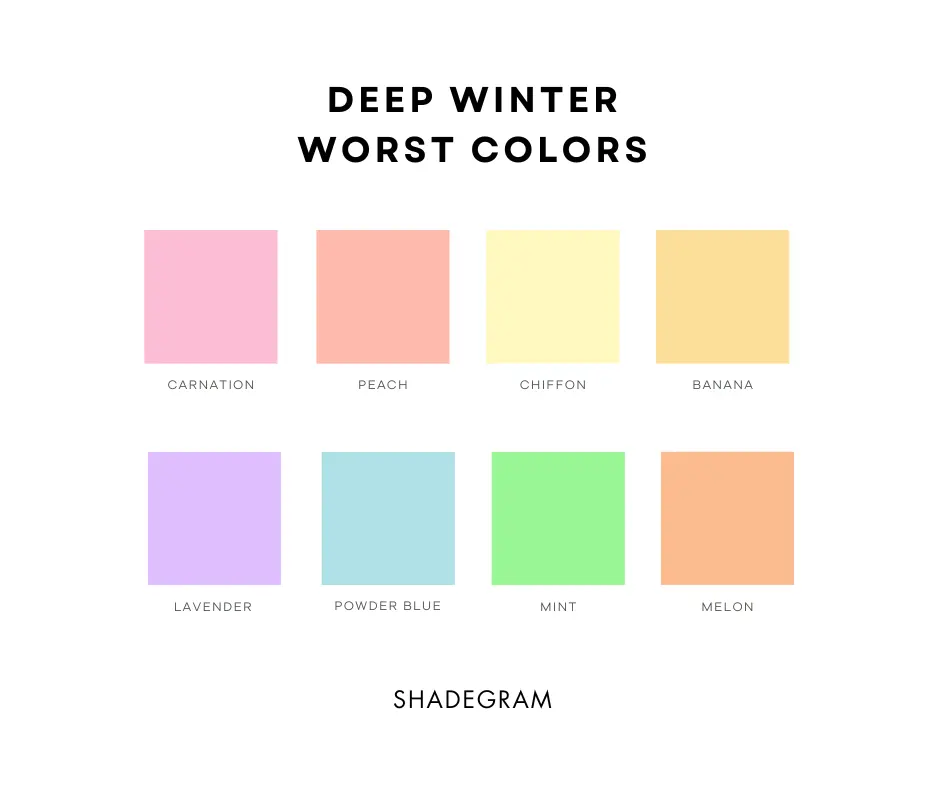
Deep winters thrive in cool, saturated, and dark colors with significant depth. Colors that are too light, warm, or muted will wash you out. Steer clear of soft pastels, beige, orange, and most earth tones, as they lack the intensity and coolness your palette demands. The opposite season is light spring.
Colors to Avoid
- Warm browns, orange, coral, mustard yellow, camel, rust, golden browns, and tans
- Light yellows, pastel shades, peach, baby blue, powder pink
- Warm reds: tomato red, warm burgundy, and muted dusty colors
Why They Clash?
These colors reduce your natural contrast and can make your complexion appear dull or tired. Instead, focus on rich, deep hues that match your cool undertone.
11. True Winter
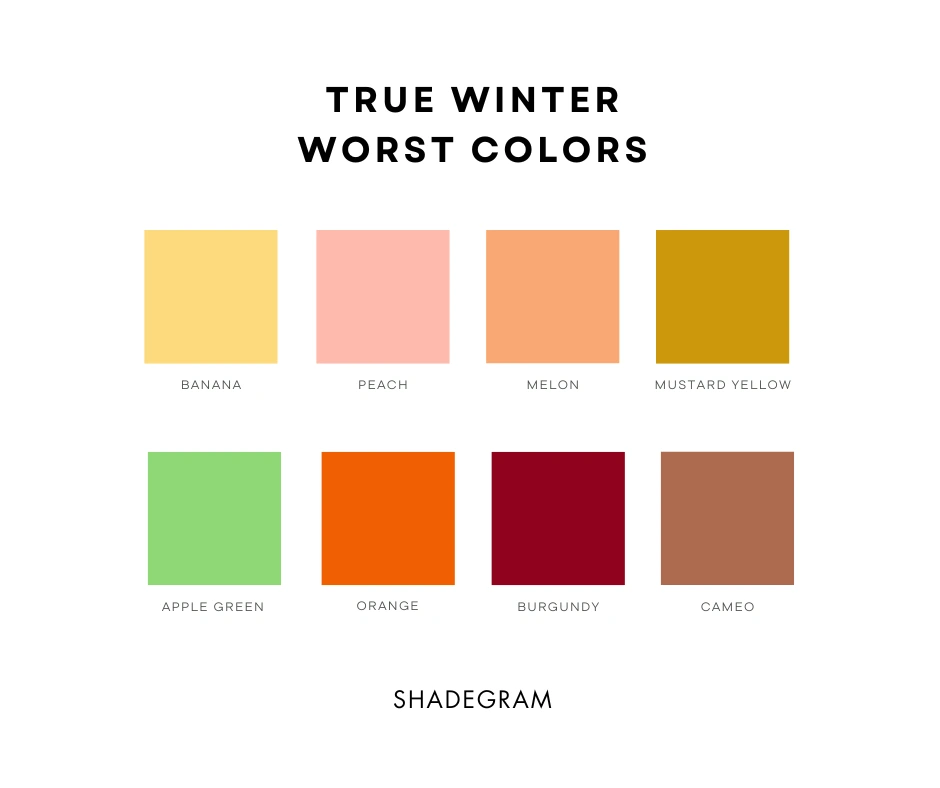
True Winter is distinguished by its cool, bright, and clear colors. Warm, muted tones will conflict most here, as they soften your natural sharpness. Be cautious of warm reds, orangey browns, and creamy shades. The opposite seasons are true autumn and true spring.
Colors to Avoid
- Warm tones: mustard yellow, camel, rust, golden browns, burnt orange, warm muted brown, apricot, cream, salmon pink, marigold, butterscotch
- Light or pastel shades: peach, baby blue, powder pink, light apple green
- Warm reds: tomato red, warm burgundy, coral
Why They Clash?
These colors soften your look and lessen the high contrast typical of true winter. Your best appearance comes from pure, bright, icy tones rather than any warm or muted shades.
12. Bright Winter
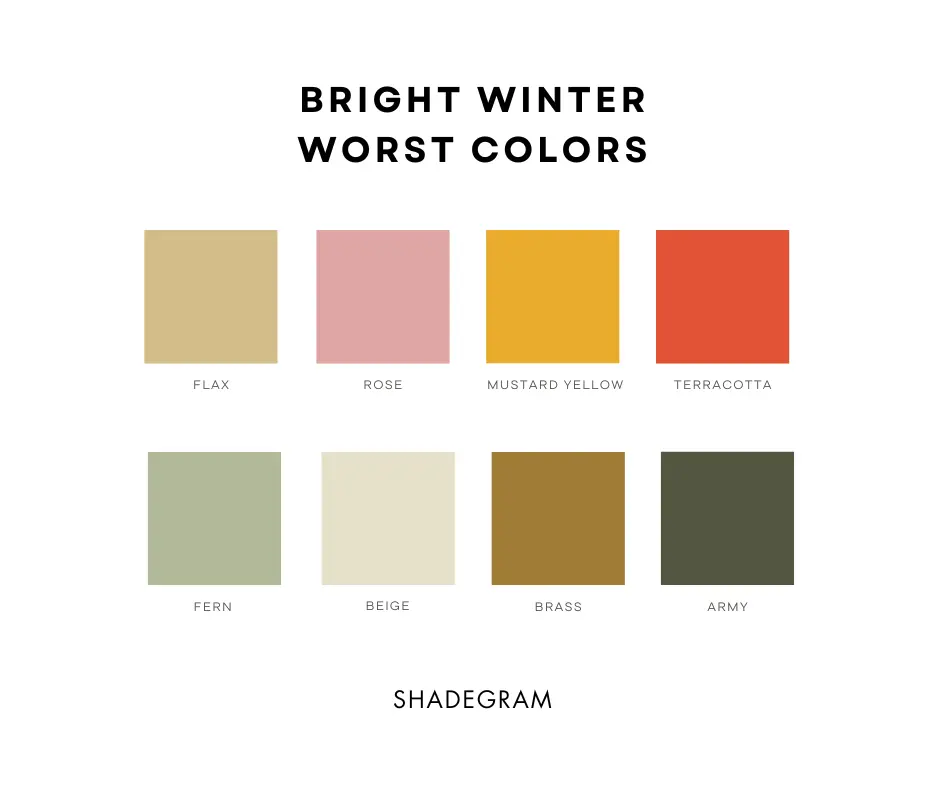
Bright Winter requires highly saturated, cool colors with vibrant intensity. Warm, dull, or overly dark colors work against your bright, clear coloring. You should avoid any colors that appear faded or earthy. The opposite season is soft autumn.
Colors to Avoid
- Warm tones: terracotta, mustard yellow, camel, toffee, brick red
- Muted shades: dusty rose, olive green, beige, warm taupe
- Very dark colors: deep brown, chocolate, dark olive
Why They Clash?
These dull your bright features and disrupt your clear contrast. Stick to clear, bright jewel tones and icy colors that reflect your crisp and vivid winter palette.
The Impact of Wrong Colors on Appearance
Choosing the wrong colors can alter how your natural features are perceived. It can make your skin appear dull, your hair and eyes less vibrant, and even affect how confident you feel in your look.
1. Effect on Skin Tone
The wrong colors can create an uneven or washed-out appearance. For example, if your skin has warm undertones, cool or overly muted colors can give a sallow or grayish cast. Conversely, cool undertones paired with warm, intense hues may make your complexion look flushed or unnatural.
The mismatches may emphasize imperfections like redness, uneven texture, or tiredness. Your skin might look lifeless rather than glowing. When you avoid these colors, your natural skin tone appears balanced and healthy.
2. Hair and Eyes
Incorrect colors can obscure the natural depth and brightness of your hair and eyes. For instance, certain shades might dull the sparkle in your eyes or cause your hair to look flat and lifeless. You may notice your eyes appearing muddy or less defined if the wrong color palette is used.
If your eyes have complex tones, such as hazel or green, wrong colors can diminish their unique highlights. Hair contrast can also be lost if colors clash with your natural hair shading.
3. Psychological Consequences
When you wear colors that don’t suit you, it can affect how you feel about yourself. You might notice a drop in confidence because the reflection in the mirror seems off or less flattering.
This discomfort can make you hesitant to engage socially or explore your personal style. Consistent use of unsuitable colors may lead to frustration or a feeling that fashion or style is inaccessible to you.
Contrasts and Overlaps in Unflattering Colors
You may notice some colors that are universally unhelpful, such as stark white or pure black, though their effects vary by season. For example, pure black can appear harsh on Soft Autumns but works well for Cool Winters due to contrast levels.
Colors like bright neon green or electric blue often appear overwhelming across multiple seasons, especially with softer or warmer coloring.
Some seasons share overlapping problematic shades, but the reason often differs. A color that washes out one season can clash sharply with another’s natural coloring.
How to Identify Your Own Worst Colors
1. Recognize Negative Visual Effects
Observe how a color changes your skin tone. Colors that make your skin look dull, washed out, or highlight imperfections are likely your worst colors.
Look for these signs:
- Skin appears sallow or overly red
- Shadows under your eyes become more pronounced
- Your natural hair color seems muted or clashed by the color
These effects indicate the color is not in harmony with your undertone and should typically be avoided.
2. Use Test Drapes for Clarity
Test draping involves holding or placing different colored fabrics near your face to see their effects clearly. You can use a mirror and natural light to evaluate.
Steps to follow:
- Use solid fabrics without patterns.
- Compare how your skin and eyes look in each color.
- Note which shades cause discomfort or diminish your natural glow.
If you can’t visit a professional color analyst, this approach is the most accurate alternative to identify conflicting colors in your wardrobe. You can also get my DIY color analysis guide to find your best colors.
3. Use Natural Lighting
Always test colors under natural daylight rather than artificial lighting. Indoor lighting can distort colors and make it hard to judge if a shade suits you.
Natural light reveals true undertones in both your skin and the colors being tested. Step outside or near a large window during midday for the most reliable results.
Without natural light, you risk misidentifying your best and worst colors, and it may lead to wardrobe choices that undermine your appearance.
How to Recover from Selecting the Wrong Colors
If you find yourself wearing colors that don’t complement your seasonal palette, certain adjustments can help minimize the mismatch. You can tweak your overall look with simple styling changes and select accessories that bring harmony back to your outfit.
1. Styling Adjustments
Start by altering how you wear the color. Layer a neutral, season-appropriate jacket or cardigan over the piece in question. It limits how much of the wrong color is visible near your face, where it matters most.
You can also balance the impact by pairing the color with garments in your best shades. For example, if you’re wearing a clashing top, combine it with bottoms or shoes in colors that flatter your season.
Switch the location of the color on your body helps too. Avoid the wrong shade close to your skin and use it in less prominent areas like belts or scarves.
2. Accessories to Offset Impact
Use accessories strategically to complement or neutralize the wrong colors. Scarves, necklaces, or earrings in your true color palette create visual breaks and redirect attention.
Metallic accessories can also influence how colors appear. For instance, if the wrong color is too warm, silver jewelry tends to cool the look, whereas gold adds warmth to cool tones.
Opt for eyewear, hats, or bags in shades that enhance your season. These elements can anchor the outfit, and provide a sense of color cohesion even if one item is off-season.
Evolve Your Wardrobe After Color Analysis
You need to shift your wardrobe toward colors that complement your unique season. Remove shades that don’t suit you and introduce reliable base pieces in your ideal palette.
Phase Out Unflattering Colors: Identifythe specific colors that clash with your season. These shades often dull your complexion or create a harsh contrast. Gradually remove these from your wardrobe to free up space and mental energy for better options.
You don’t have to discard everything at once. Instead, prioritize removing the most obvious offenders first, such as neon or overly warm/cool hues that don’t match your undertones. Consider donating or selling these pieces to avoid wasting clothing.
Keep in mind that some colors might be fine for accents or accessories but not for core garments close to your face. The strategy helps limit poor color choices without making an abrupt or costly overhaul.
Select New Foundations for Your Palette
After you’ve cleared out the unflattering colors, focus on acquiring essential wardrobe staples in your seasonal palette. Base pieces like jackets, trousers, and blouses should reflect your best hues to provide a cohesive and versatile foundation.
Use a color chart tailored to your 12-season category to guide your selections. Choose shades that work well for mixing and layering.
Aim to build a capsule wardrobe where every item coordinates well. The approach simplifies outfit choices. Prioritize quality basics over trends to maintain consistency and value.
Summing Up
Understand your personal color palette, and your “anti-palette,” to empower your style, and not limiting it. Avoid colors that drain your radiance and embrace those that enhance it.
You can elevate your appearance and boost your confidence. Conscious color choices help you look and feel your best, making every fashion decision intentional.
The guidelines are useful, but trust your instincts and how you feel in different colors. Comfort and confidence are key.
Download your best and worst colors based on your season, and keep them handy for easy reference when shopping or planning outfits. Make every color choice work for you!

